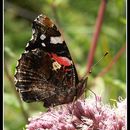en
names in breadcrumbs


The distinctive red-orange band across the wing of the Red Admiral makes this butterfly species easy to distinguish from other species. The common name "Red Admiral" compares this band to the chevrons on a naval uniform.
The red admiral butterfly may appear to be rare at the outer edges of its range, but it is thought to be a secure species globally.
US Federal List: no special status
CITES: no special status
State of Michigan List: no special status
The adult stage of the Red Admiral is rarely harmful because mature Red Admiral butterflies feed mainly on nectar. The caterpillar stage, however, damages the plants that it feeds on, though it is not generally known to be an agricultural pest. The plants the Red Admiral caterpillars tend to eat include nettles, hops, and pellitory.
The aesthetic beauty of the Red Admiral is one of the most underrated values of this species. Due to the Red Admirals wide-spread range throughout the Americas, Europe, and Asia, their beauty can be enjoyed by many. Red Admirals are often found nectaring at red clover, aster, and Buddleia flowers; this combination of flowers and butterflies further enhances their aesthetic value.
Mature Red Admirals tend to feed on fermenting fruits, bird droppings, and sap from trees. Adult Red Admirals are fond of nectaring at composite flowers, such as milkweed, aster, and alfalfa. The food sources for the larva include nettles from the genus Urtica, pellitory from the genus Parietoria, and hops from the genus Humulus.
Plant Foods: leaves; nectar; flowers; sap or other plant fluids
Primary Diet: herbivore (Folivore , Nectarivore )
The range of Red Admirals extends around the Northern Hemisphere, from northern Canada to Guatemala in the western hemisphere, and from Scandinavia and northern Russia south to North Africa and China in the east. It is established on Bermuda, the Azores, and the Canary Islands in the Atlantic, and the Hawaiian islands in the Pacific. It has been introduced to and breeds in New Zealand as well.
Biogeographic Regions: nearctic (Native ); palearctic (Native ); oriental (Native ); neotropical (Native ); oceanic islands (Introduced , Native )
Other Geographic Terms: holarctic
Red Admirals tend to be found in moist environments such as marshes, woods, fields, and well-watered gardens. These butterflies cannot stand extreme winter cold and are forced to migrate southward during the winter months to warmer climates. During this migration they can be found in habitats ranging from subtropics to tundras. The caterpillars of this species live on the plants they feed on (see Food Habits below).
Habitat Regions: temperate ; terrestrial
Terrestrial Biomes: savanna or grassland ; forest
Wetlands: marsh
Other Habitat Features: suburban
The characteristic coloration of the Red Admiral Butterfly is a black hindwing with a red-orange marginal band; the dorsal forewing is also black with white markings near the apex. The wing span of the Red Admiral ranges between 1.75 and 3 inches. These butterflies tend to have a brighter coloration and a larger body mass during the summer months than during the winter. The legs and eyes of the Red Admiral tend to be hairy and the head is moderately large.
A mature caterpillar of the larvae stage is cylindrical in shape and has branching spines arranged in rows lengthwise.
Other Physical Features: ectothermic ; heterothermic ; bilateral symmetry
Male Red Admirals are territorial butterflies that patrol their areas in order to find female mates. The males typically perch upon sunlit spots, in the mid-afternoon, to wait for females to fly by. Once fertilized, female Red Admirals will lay their eggs on the upper surface of host plant leaves. The majority of Red Admiral butterflies are double-brooded (two generations grow a year); however, in Canada and the northern part of the United States they are single-brooded (one generation a year), and in the southern United States they are triple-brooded (three generations a year).
The general life cycle of the Red Admiral butterfly goes from an egg, to a caterpillar (pupate in a chrysalis), that emerges as an adult. The adult then mates, oviposits, and starts the cycle again.
Key Reproductive Features: semelparous ; seasonal breeding ; gonochoric/gonochoristic/dioecious (sexes separate); sexual ; fertilization (Internal ); oviparous